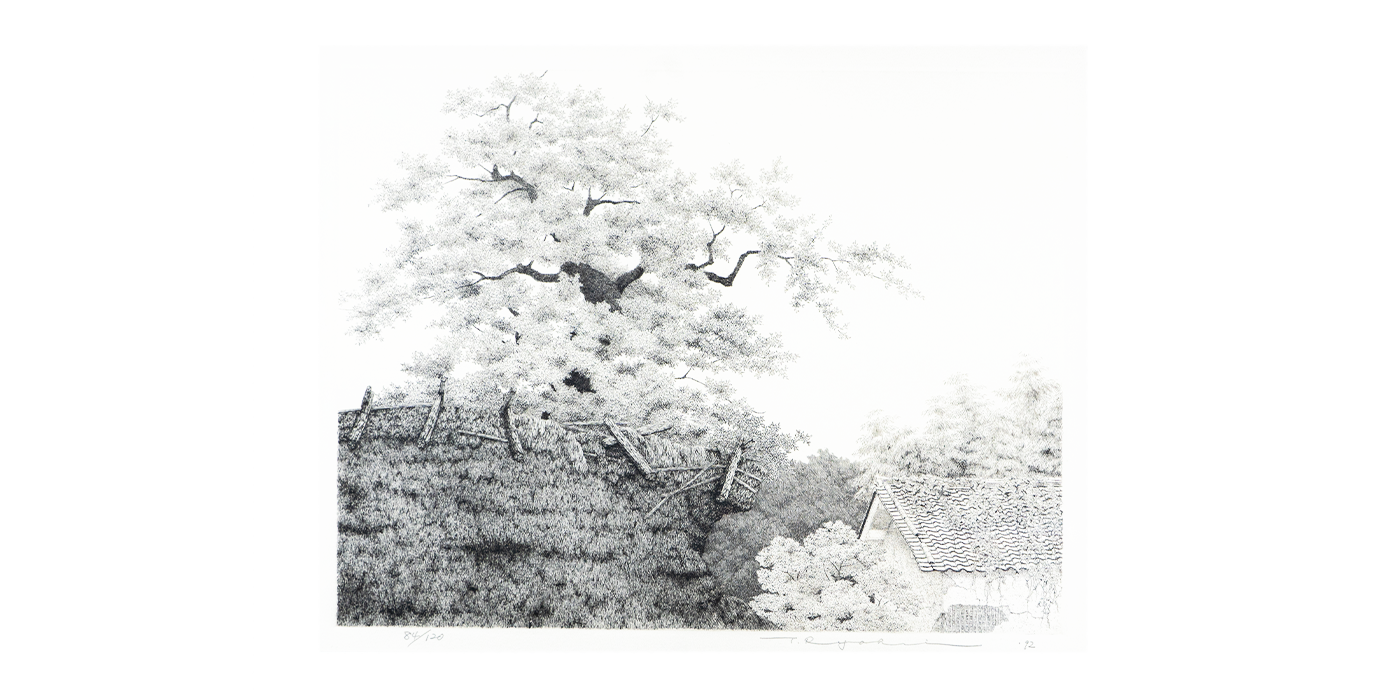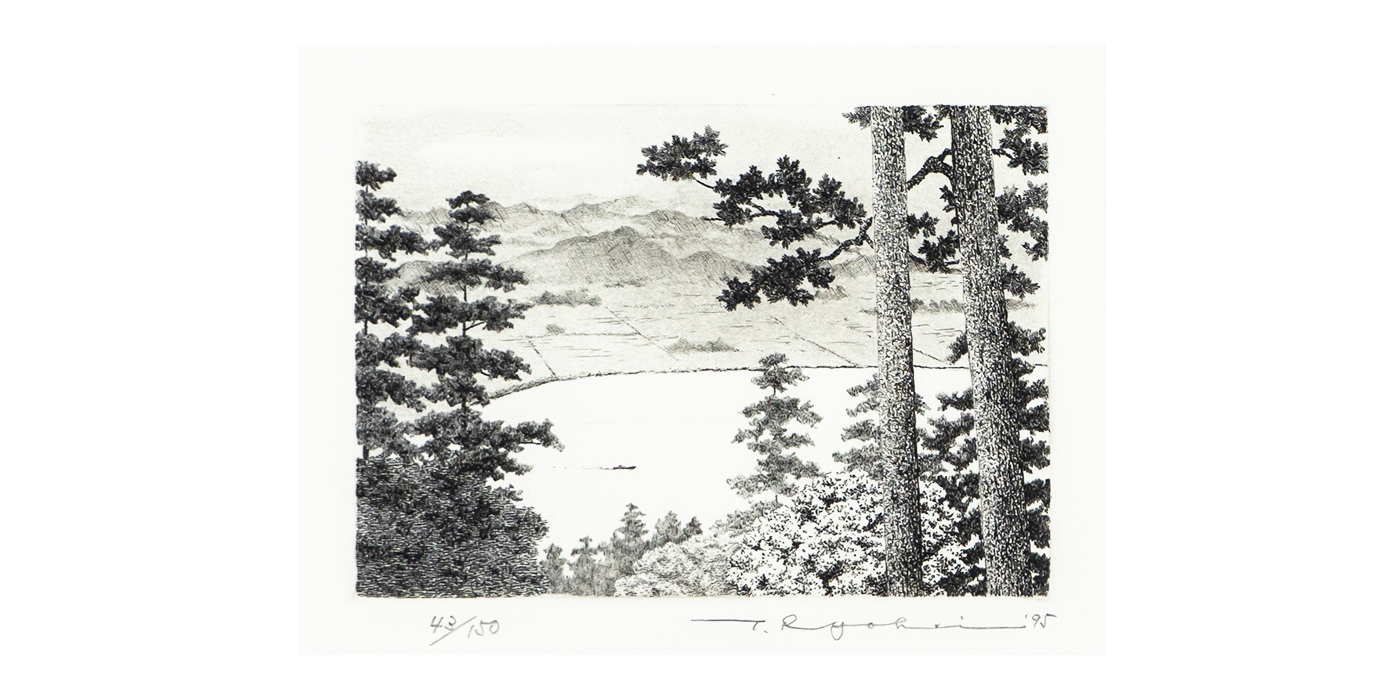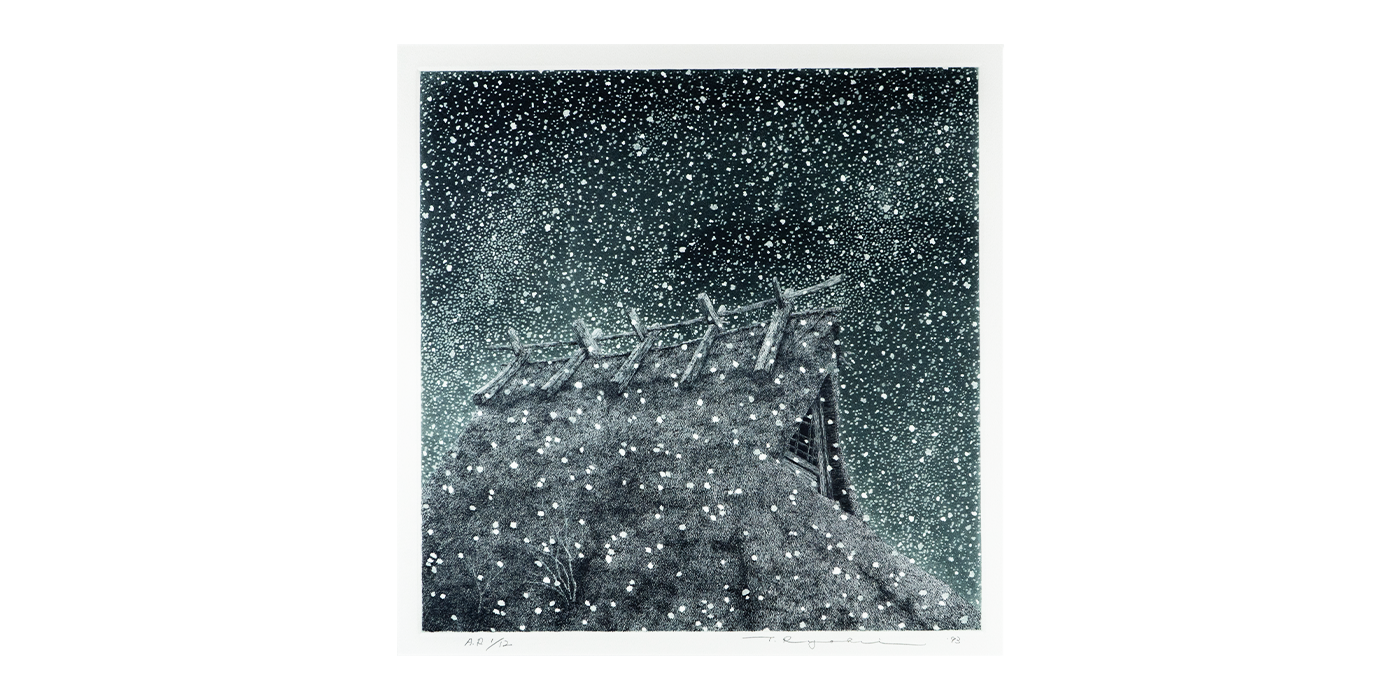 “Winter Snow”
“Winter Snow”
(A.P. 6/10). This black and white 12.75″ x 12.75″ etching, depicts a solid thatched roof structure in good condition with snow mounds and a leafless tree in the foreground. The print reminds one of a somewhat melancholy Japanese winter. It is signed T. Ryohei ’95 in pencil at the lower right corner.
 “Trees in Summer”
“Trees in Summer”
(68/150). This 3.25″ x 4.25″ image is a detail of a large tree as one looks up through the branches. It is a study in textures, juxtaposing intricate textures of bark and leaves, against the rugged trunk structure and a soft pale sky. It is signed T. Ryohei ’97 in pencil at the lower right corner.
 “Water’s Edge”
“Water’s Edge”
(A.P. 13/15, INE no. 3). This black and white 8.25″ x 9″ etching captures village life at the water’s edge. Compact houses line the immediate shoreline while fishing boats are moored calmly a short distance away.
It is signed T. Ryohei ’89 in pencil at the lower right corner.
 “Crow 4”
“Crow 4”
(85/150). The 3″ x 5″ image depicts two silhouetted crows siting among intricately etched tree limbs in a winter’s daylight. It is signed T. Ryohei ’92 in pencil at the lower right corner.
 “Chi shaku-In”
“Chi shaku-In”
(52/150). This 8.25″ x 6.25″ etching and aquatint image depicts a garden of Chi shaku-In, a Buddhist temple located at the eastern end of Kyoto’s Shichijo Street. Tanaka Ryohei captures the rich plant life along the bank of a river with a small waterfall and bridge above. In the foreground one sees wooden planks which may be part of a veranda from which to observe the garden from the temple. Signed T. Ryohei ’02 in pencil at the lower right corner.
 “Return to Earth”
“Return to Earth”
(42/120). In this 13.75″ x 18.25″ image, moonlight exposes a traditional wooden structure with a thatched roof that is slowly being reclaimed by the elements. Ryohei carefully records the disappearance of traditional rural life of Japan. The print is signed T. Ryohei ’93 in pencil at the lower right corner.
 “Tsuiji, Pine Trees”
“Tsuiji, Pine Trees”
(35/130). A 9.5″ x 11.5″ detailed etching of a wall of three impressive trees with thatched and tile roofs in the lower background. It is signed T. Ryohei ’96 in pencil at the lower left corner.
 “Thatched Roofs in Rural Scenery”
“Thatched Roofs in Rural Scenery”
(48/130). This 9.5″ x 15.5″ image depicts three thatched-roofed buildings with an entry path. A window in the door of the largest building draws the viewer’s attention and conveys a subtle sense of human presence. The etching is signed T. Ryohei ’97 in pencil at the lower right corner.
 “Ruin” (Sasayama)
“Ruin” (Sasayama)
(84/120). The 12″ x 15.5″ image depicts a large tree in full bloom rising above a dilapidated thatched roof with a second tile-roofed structure adjacent. An open sky of negative space contrasts with the rich texture and detail of the roofs and tree. The etching is signed T. Ryohei ’92 in pencil at the lower right corner.
 “Path”
“Path”
(61/100). This 4.5″ x 3.25″ image depicts a path next to a rock wall with dense bamboo on either side, and with a high tree-covered canopy above. It is signed T. Ryohei ’00 in pencil at the lower left.
 “Winter Day”
“Winter Day”
(44/100). This 3.25″ x 4.25″etching depicts a small village or farm buildings in the distance surrounded by cultivated land and thick wooden underbrush. A small ancillary building stands in the foreground. It is signed T. Ryohei ’99 in pencil at the lower right corner.
 “Rainy Togetsukyo Bridge”
“Rainy Togetsukyo Bridge”
(132/150). This 3.5″ x 4.75″ image depicts an impressive bridge over water with three people carrying umbrellas while crossing. In the foreground are diagonal streaks, suggesting heavy rain. It is signed T. Ryohei ’95 in pencil at the lower right corner.
 “Summer Day No. 7”
“Summer Day No. 7”
(16/150). This 4″ x 4″ image depicts a thatched roof building with typical peak roof structure, nestled against a hillside and surrounded by lush foliage. It is a masterpiece of juxtaposed textures and negative spaces. It is signed T. Ryohei ’98 in pencil at the lower right corner.
 “Chomeiji-Temple”
“Chomeiji-Temple”
(43/150). This small 3″ x 5″ image captures a view through two impressive trees to a body of water below with hills and cultivated land at a distance. The view of Lake Biwa is seen from Chomeiji-Temple. It is signed T. Ryohei ’95 in pencil at the lower right corner..
 “Mountain Village in May”
“Mountain Village in May”
(47/150). A 4″ x 4″image depicting a view from a higher elevation of a mountain village with terrace farming in the foreground. The terraces appear to cascade toward the village below with hedges and walls defining each terrace. It is signed T. Ryohei ’90 in pencil at the lower right corner.
 “Snow Falling on Farm”
“Snow Falling on Farm”
(108/120). In this 9.5″ x 11.5″ etching, one’s eye is drawn along the road to the center of the farm. The sky is full of large snowflakes falling on the buildings and the surrounding landscape. The composition, with its many elements, seems to depart somewhat from Ryohei’s style. The overall affect is to feel drawn into the center of something still to be discovered. It is signed T. Ryohei ’95 in pencil at the lower right corner.
 “Snow and Thatched Roof”
“Snow and Thatched Roof”
(A.P. 1/12). This etching and aquatint printed in green depicts a thatched roof building at night during a heavy snow fall. The piece is signed T. Ryohei ’93 in pencil at the lower right corner.
 “Temple in Mountain”
“Temple in Mountain”
(A.P. 4/15). This richly textured and detailed 3.5″ x 4.75″ etching and aquatint depicts an ornamented tile-roofed building surrounded by thick trees and underbrush. The building almost appears to have grown in this environment, as did the plants. It is signed T. Ryohei ’91 in pencil at the lower right corner.



 Tanaka Ryohei is world-renowned for his intricate etchings of rural Japan. He is best known for his black and white etchings, but he also produced some aquatints and mezzotints. Ryohei did not imagine his compositions, but drew from reality, basing his work on his own sketches of the Japanese countryside. He was passionate about rural Japanese life and through his etchings, captured much of its disintegration in modern times, particularly apparent in “Return to Earth.”
Tanaka Ryohei is world-renowned for his intricate etchings of rural Japan. He is best known for his black and white etchings, but he also produced some aquatints and mezzotints. Ryohei did not imagine his compositions, but drew from reality, basing his work on his own sketches of the Japanese countryside. He was passionate about rural Japanese life and through his etchings, captured much of its disintegration in modern times, particularly apparent in “Return to Earth.” Etching is an intaglio printmaking process in which lines or areas are incised using acid into a metal plate in order to hold the ink where aquatint uses powdered rosin (resin) to create a tonal effect.
Etching is an intaglio printmaking process in which lines or areas are incised using acid into a metal plate in order to hold the ink where aquatint uses powdered rosin (resin) to create a tonal effect. “Winter Snow”
“Winter Snow” “Trees in Summer”
“Trees in Summer” “Water’s Edge”
“Water’s Edge” “Crow 4”
“Crow 4” “Chi shaku-In”
“Chi shaku-In” “Return to Earth”
“Return to Earth” “Tsuiji, Pine Trees”
“Tsuiji, Pine Trees” “Thatched Roofs in Rural Scenery”
“Thatched Roofs in Rural Scenery” “Ruin” (Sasayama)
“Ruin” (Sasayama) “Path”
“Path” “Winter Day”
“Winter Day” “Rainy Togetsukyo Bridge”
“Rainy Togetsukyo Bridge” “Summer Day No. 7”
“Summer Day No. 7” “Chomeiji-Temple”
“Chomeiji-Temple” “Mountain Village in May”
“Mountain Village in May” “Snow Falling on Farm”
“Snow Falling on Farm” “Snow and Thatched Roof”
“Snow and Thatched Roof” “Temple in Mountain”
“Temple in Mountain”